How are Doorbells Wired? (Circuit Design, Wiring, Tips)
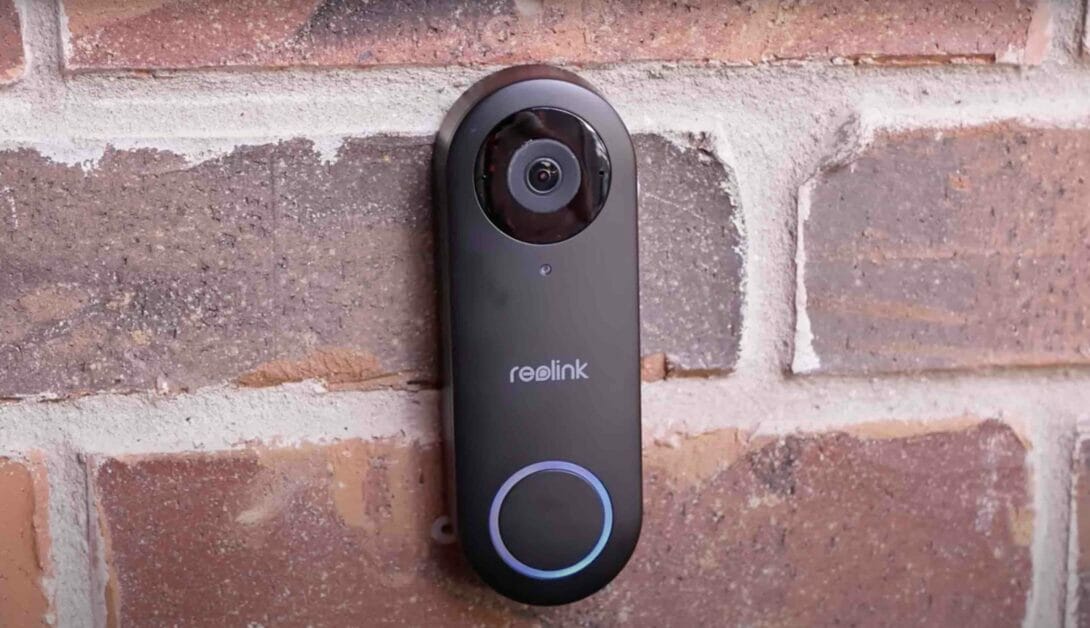
Ever wondered how that friendly ‘ding dong’ gets triggered every time someone’s at your door? Well, we’re about to break it down.
We’ve got three major players in this game: the doorbell, the push-button switch, and the under-20V transformer. Together, they play a symphony on a 20/2 wire stage, sending signals when someone’s at your door. But a wrong note can throw everything off, even in a perfectly orchestrated system. So, I’ll also share some secrets for fixing common doorbell hiccups.
You’re about to discover that an intricate low-voltage circuit is at play under the bell’s chime. Even though we now have those fancy wireless doorbells, we’re going old school, focusing on the classic wired ones.
Grab your voltmeter, screwdriver, and wire stripper, and let’s wire up that doorbell!
A Doorbell Circuit
A doorbell is usually powered by a low-voltage transformer that reduces 120V current to a lower voltage current of 20V or less. Current flows from the transformer to a push-button switch. When pressed, the switch activates the magnetic coil inside the doorbell unit.
This type of circuit is technically a signaling one because it involves energizing certain signaling equipment. It may be a bell, but it could also be a chime, a buzzer, a signal light, or a code-calling system. Here’s what it would typically look like with a chime:
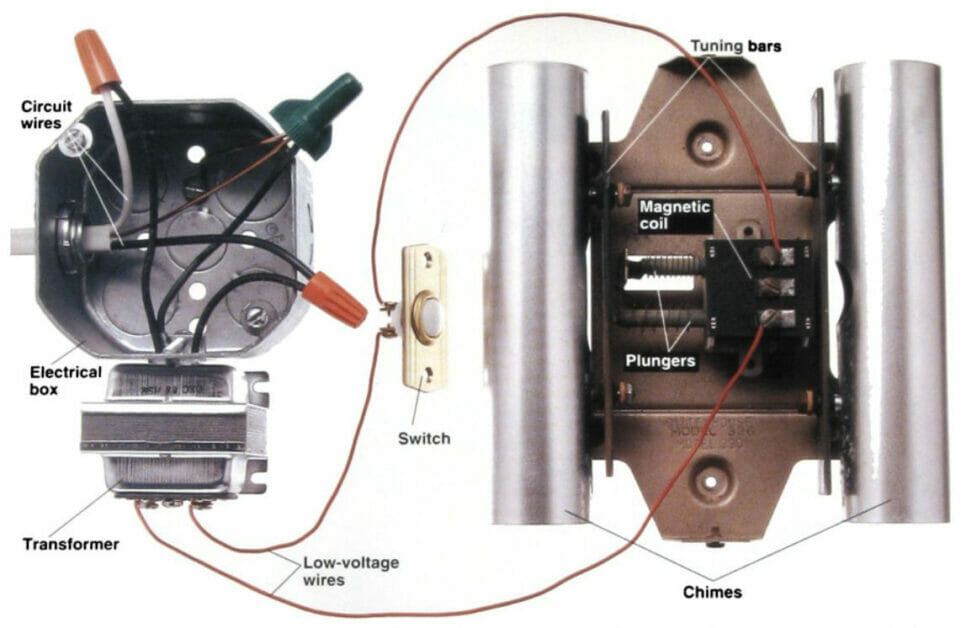
Although wireless doorbells are available nowadays, this article is about installing a wired doorbell.
Project Requirements
You will require the following items, tools, and other equipment for doorbell wiring.
| Items | Tools and Testing Equipment |
| Doorbell (or chime) Transformer (<20 volts) Push-button switch (as many as required) 20/2 wire | Voltmeter or multimeter Screwdriver Wire stripper Nose pliers |
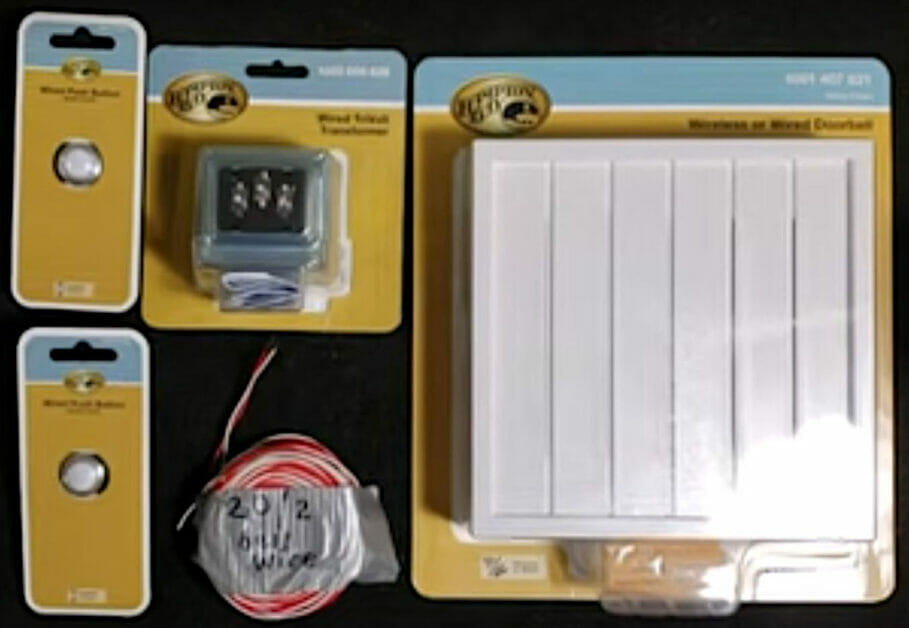
You can install any doorbell you choose, but check its requirement for wired operation. It should be stated in the packaging. In this example, it shows it needs a 16VAC step-down transformer. Only use a transformer of the required type.
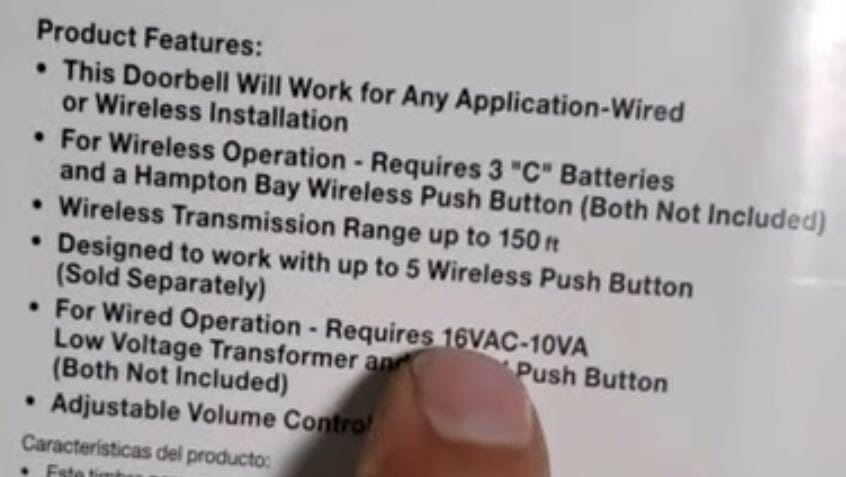
Note that you only need a transformer if the doorbell operates on a lower voltage, as some don’t require one.
The length of the wire will depend on the distance from the switch to the location of the doorbell and transformer.
Wiring a Doorbell
From the Doorbell to the Switch
The wire should stretch from the doorbell and transformer inside to the switch outside.
Please choose a suitable path for the wires and secure them to the wall. Keep the low-voltage wire away from your regular house wiring.
At the Doorbell Side
You will see three connection points (terminals) at the doorbell side, marked ‘Front,’ ‘Trans,’ and ‘Rear.’
Connect one of the wires coming from the switch to the front terminal, which is red in this example:
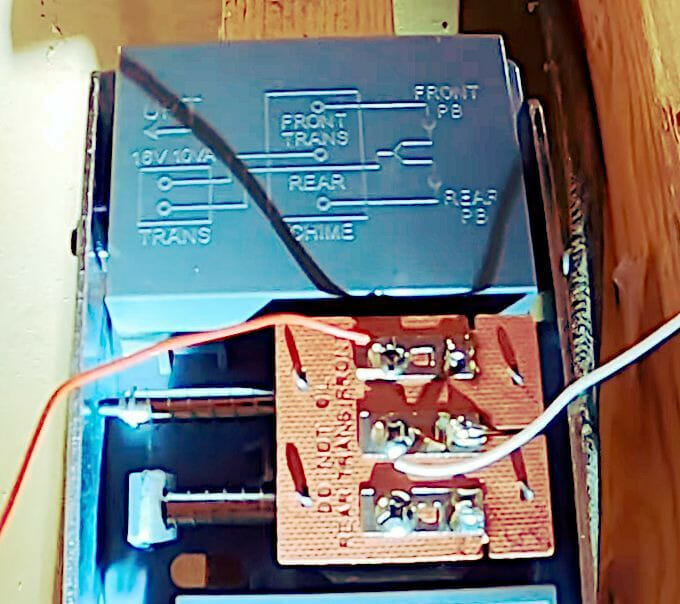
The other white wire from the switch and the white wire on the ‘trans’ terminal on the doorbell will go to the transformer.
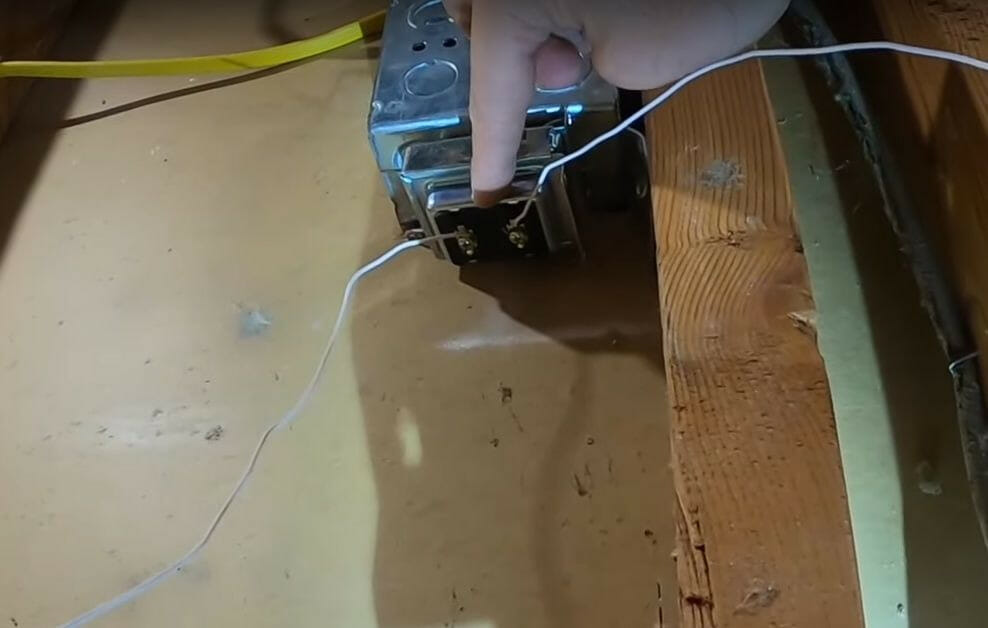
In this example, the wiring coming to and between the doorbell and transformer look like this:
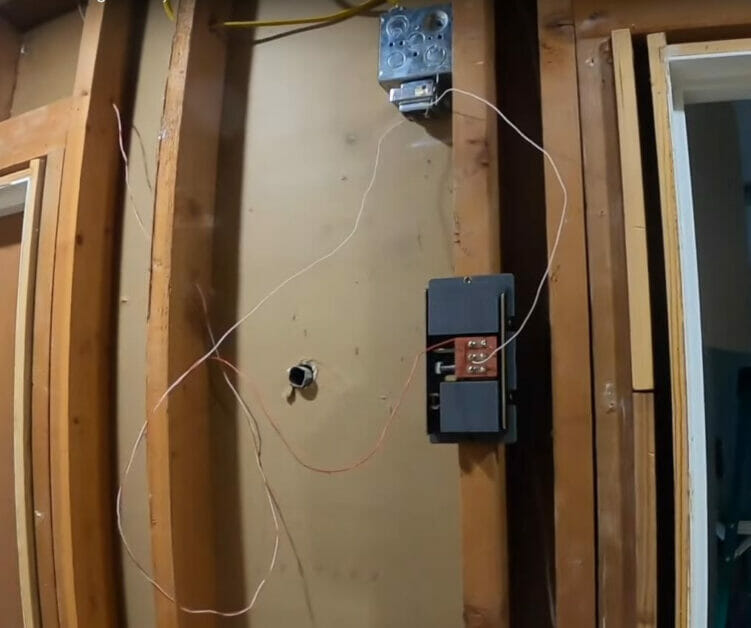
At the Doorbell Switch Side
At the doorbell switch side, you only need to connect the two thin wires to the back of the switch.
It doesn’t matter which one goes where because the switch comes in between the same wire.
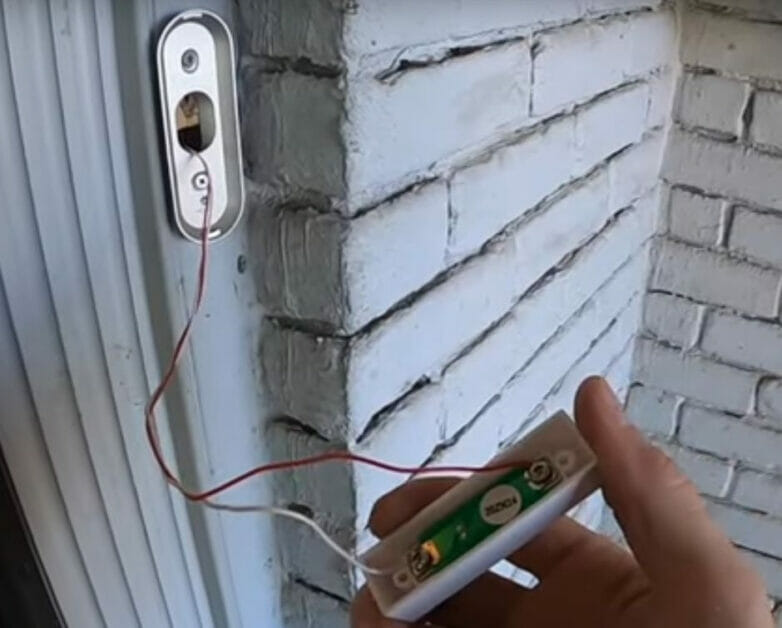
Fixing Problems
A loose wire connection or a worn-out switch usually causes doorbell problems.
However, they can also arise if the doorbell becomes dirty or if the transformer burns out. Because doorbells operate at low voltage, you can service the doorbell and switch without turning the power off to the system, except when replacing the transformer, in which case it is necessary to turn it off at the main panel.
Here’s what to do:
- Test for suspected wire breaks using a multimeter. Do a continuity test. Replace the wire if a break or weak point is confirmed.
- If you notice the switch is worn out or damaged, replace it.
- The voltage output from the doorbell transformer to the doorbell should be no more than 20 volts. Check this using a voltmeter or multimeter.
Checking and Testing the Doorbell
If you suspect loose connections, check the low-voltage wires on the doorbell’s terminals, using nose pliers to ensure they are secure.
Set the multimeter within the 20 or 50V AC range, as available. Touch the FRONT and TRANS terminals of the doorbell with the multimeter’s probes.
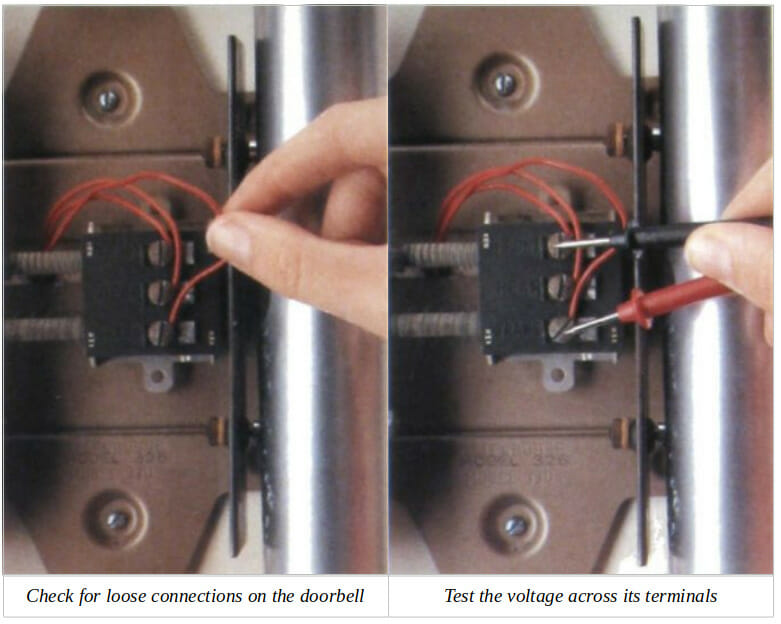
The power to the doorbell unit should be within 2V of its voltage rating.
So, if the doorbell operates at 16V, the actual voltage should lie within the range of 14-18V. If the multimeter detects no or very low power, there may be a break or weak point along the circuit. In that case, you must inspect the wires and replace the weak or broken ones.
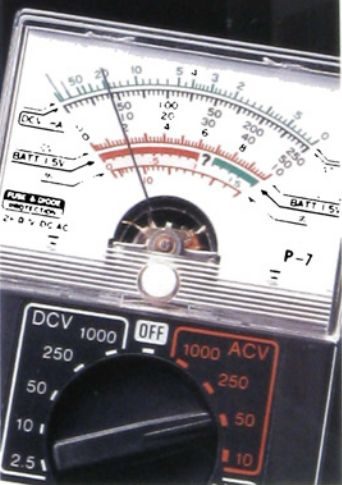
Checking and Testing the Transformer
If you suspect loose connections, check the low-voltage wires on the transformer’s terminals to ensure they are secure, using nose pliers.
Set the multimeter within the 20 or 50V AC range, as available. Touch the multimeter’s probes to the low-voltage terminals of the transformer.
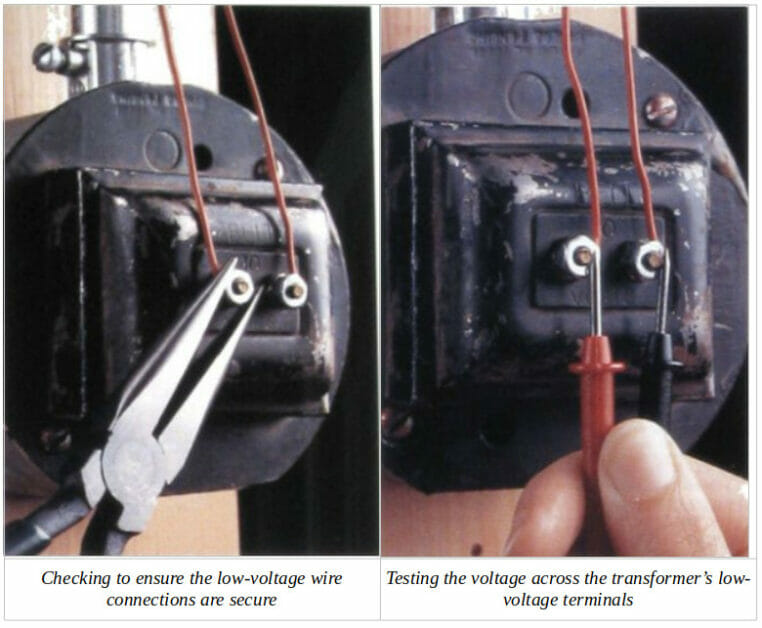
Again, the voltage reading should be within 2V of the transformer’s rating. So, if its output is 16V, the actual voltage should be no less than 14V and no more than 18V.
Check the Doorbell’s Plungers
If all the wires to the switch, doorbell, and transformer are fine, clean the plungers with a cotton swab dipped in rubbing alcohol and repeat the test by pushing the switch. If the doorbell fails to work, the unit may need to be replaced.
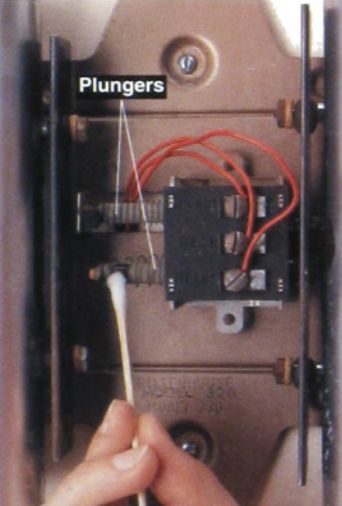
FAQs
Can I wire a doorbell without professional help?
Yes, you can wire a doorbell by yourself if you understand electrical systems. However, always take precautions when dealing with electricity; if you are unsure, it’s better to seek professional help.
How can I tell if my doorbell transformer is bad?
A malfunctioning doorbell can be due to a faulty transformer. If the doorbell isn’t ringing or is ringing inconsistently, check the transformer’s voltage with a multimeter. It may be defective if the reading doesn’t match the output written on the transformer.
How often should I replace my doorbell?
A well-maintained doorbell system can last many years, even decades. However, it might be time for a replacement if you notice any persistent issues despite troubleshooting or if the system is old and parts are hard to find.
Can I convert my wired doorbell to a wireless one?
Yes, you can replace a wired doorbell with a wireless one. The process involves removing the old doorbell and installing the new wireless button. You would then set up the wireless receiver inside your home where you can hear it.
What does it mean if my doorbell rings by itself?
If your doorbell rings by itself, it might be due to a short circuit in the wiring, a sticking button, or a problem with the transformer. Check each component and replace any that are defective.
What type of wire is used for doorbells?
Typically, a low-voltage wire, such as a 20/2 wire, is used for doorbells. The “20” refers to the wire gauge, and the “2” indicates the number of conductors.
Remember, safety should always be the primary concern when dealing with electrical components. Always turn off the power when working on the doorbell system, and consult a professional if unsure about any step.
References
Black & Decker. The complete guide to home wiring: A comprehensive manual, from basic repairs to advanced projects. Creative Publishing. 2001
Video References
LifeHackster
AtHomeDIY
Craft Customs
